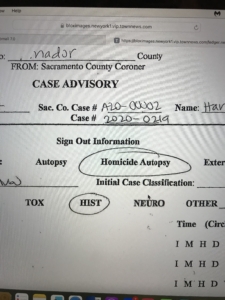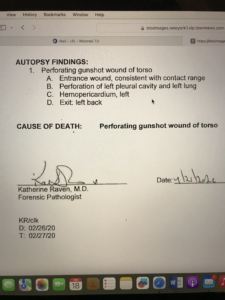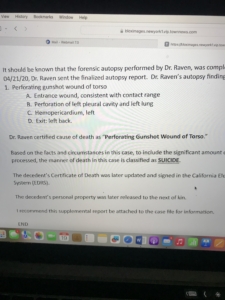


On February 21, 2020, in Amador County, California, Philip Haney, 66, was found dead from a gunshot. Means and opportunity were apparent, but a shooting death always involves a motive. The possibilities in Haney’s case loomed large.
The UC Riverside alum worked as an agricultural entomologist in the Middle East, where he began studying Arabic and the Quran. With that background, Haney seemed a good fit for the Department of Homeland Security, but when he tracked down Muslim terrorists the DHS bosses had a problem.
In “DHS ordered me to scrub records of Muslims with terror ties,” published in The Hill on May 5, 2016, Haney said DHS had ordered him “to delete or modify several hundred records of individuals tied to designated Islamist terror groups like Hamas from the important federal database, the Treasury Enforcement Communications System (TECS).”
The DHS whistleblower also authored Frontpage articles, “Deobond Attacks in San Bernardino, Sri Lanka,” “The Terrorist Ties that Bind,” and “The Assembly of Muslim Jurists of America’s Ominous Post-Election Statement.” The expert on Islamic jihad had been punished for doing his job and decided to write about it.
In 2016 Haney authored See Something Say Nothing: A Homeland Security Officer Exposes the Government’s Submission to Jihad. In November of 2019, Haney told the Washington Examiner it was odd that he was a “highly visible whistleblower that virtually no one listened to, while this guy [alleged Ukraine whistleblower Eric Ciaramella] remains invisible, but is treated like an oracle from above.” Once again, Haney planned to set the record straight.
“I have a severely hyper-organized archive of everything that’s happened since See Something, Say Nothing (SSSN) was published in May of 2016,” read his November 11, 2019 text. “The National Security Meltdown sequel will pick up right where SSSN left off. My intention is to have it ready by early to mid-Spring of 2020 (just before the political sound wave hits), then ride that wave all the way to the Nov. elections.” On February 21, 2020, the highly visible whistleblower turned up dead by gunshot.
News of a shooting is normally accompanied by reports of possible suspects and a manhunt to find the shooter. In this case, rumors of suicide were quick to emerge, and strongly denied by those who knew Haney, including Reps. Louis Gohmert and Steve King. The Amador County Sheriff’s Office (ACSO) initially called reports of suicide “misinformation,” and put off any determination until “all evidence is examined and analyzed.”
The ACSO scheduled a forensic autopsy and “reached out to our law enforcement partners in the Federal Bureau of Investigation (FBI) to assist in analyzing documents, phone records and a laptop that were recovered from the scene and Mr. Haney’s RV.” As these events unfolded, the case caught the attention of national media.
“Haney’s controversial accusations that the Obama administration could have prevented terrorist attacks were polarizing among Americans,” Laura Hoy of CNN reported on February 23. As Hoy explained, “Haney’s death is likely to become political ammo for Republicans heading into the 2020 presidential elections.”
On July 22, the ACSO announced “hopes to complete our review of the reports and compare the FBI’s analysis with what we have already collected and analyzed within a few weeks after receipt.” A week after the November election, the FBI “analysis” had not come to light, so Haney’s death did not become “political ammo for the Republicans.”
The July 2020 press release disappeared from the Amador website and in February of 2021, the ACSO told Frontpage there was no new information and would say nothing about the case. In April of 2021, Sheriff Martin Ryan retired, replaced by former undersheriff Gary Redman, “a graduate of the Federal Bureau of Investigation’s National Academy,” in Quantico, Virginia.
As Redman told the local Ledger Dispatch, “We are waiting for a few remaining pieces to be analyzed out of Virginia,” but there was “no estimated time of arrival.” As the second anniversary approached, Amador authorities told Frontpage there was no news on Haney and that the case was closed. The next month, more than two years after Haney was found dead from a gunshot, Redman proclaimed Haney’s death a suicide and declared the case officially closed. As the graduate of the FBI academy had to know, it wasn’t.
According to forensic pathologist Katherine Raven MD, cause of death was a “perforating gunshot wound of torso,” approximately one inch in diameter and “consistent with contact range.” Dr. Raven found an exit wound on the left side of the back and abrasions on both knees. The forensic pathologist signed out “homicide autopsy,” but Lieutenant Jim Cardoza of the ACSO didn’t think so.


“Based on the facts in this case, to include the significant amount of evidence collected and processed, the manner of death in this cases is classified as a suicide.” That was based on a February 14, 2022 physician/coroner’s amendment by Patrick R. Weart, the “deputy coroner,” who listed “apparent self-inflicted gunshot wound” as the cause of death.
In Amador County, the sheriff doubles as the coroner and the chief deputy coroner is a sergeant assigned to the investigations division. In Amador County, Patrick Weart served as “Sheriff’s Sergeant Advanced,” but no information on any medical training that might have qualified Weart to rule Philip Haney’s death an “apparent” self-inflicted gunshot wound.
That was not the language of Katherine Raven, who earned her medical degree at the University of Nevada in 1991. Dr. Raven signed out on a “homicide autopsy,” and in a homicide one person causes the death of another. To that possibility, the ACSO and FBI gave not the slightest attention. Consider the January 13, 2022 report prepared by Lt. Cardoza, and approved by undersheriff Jarret Benov, with all emphases in the original text:
On 04/02/20 I documented in a previous supplemental report, sending the collected thumb drives to the FBI for examination. After those thumb drives, as well as a laptop from the motorhome were processed, FBI senior supervisory agent Simon Maher, contacted me and said he was going to take another look at the electronics to decide if they contained classified material or other governmental documents considered to be contraband.
On 01/13/22 I received a Digital Evidence Review report from Agent Maher, wherein Agent Maher indicated there were three devices he considered to be contraband. During his examination process, three digital devices, specifically a Dell Inspiration laptop computer. [S/N blacked out] a 32 gig Lexar thumb drive [S/N blacked out] and an Imitation 512 gig thumb drive [S/N blacked out] were found to contain documents that were the property of the US Department of Border Protection/Homeland security. The digital evidence report was later added to this report as an attachment.
Agent Maher then put me in contact with Eric Wilson at the U.S. Department of Homeland Security and Border Protection Office of Special Responsibility in San Francisco Ca. I explained the situation to Agent Wilson and I also sent him a copy of the Digital Evidence Review report I received from agent Maher. Agent Wilson said his agency would need to take possession of those three electronic devices due to the nature of material contained within them.
On 01/24/22 I received a letter from Agent Wilson. That letter stated the following:
Former CBPO Haney was not in legal possession, nor did he receive permission to place and/or possess the information on his personal devices. I have provided some federal legal citations which delineate former CBPO Haney’s lack of legal standing to possess such materials.
Title Five, United States Code, Section (U.S.C.) 552a – Privacy Act
Title U.S.C. 641 – public money, property or records.
Title 18 U.S.C., 1030 – fraud and related activity with computers
Title 18 U.S.C., 1906 – disclosure of information from a bank examination report
Title 18 U.S.C., 2511 – interception and disclosure of wire, oral, or electronic communications prohibited.
CPB OPR respectfully requests the ACSO remand custody of the above-mentioned items to CPB OPR for any actions deemed appropriate.
The letter from Agent Wilson was later added to this report as an attachment.
On 01/02/22 at approximately 0900 hours I responded to FBI Subdivision Headquarters located in Roseville, California, where I contacted agent Maher. I then took possession of all the materials that had been sent to, collected, and processed by the FBI. That evidence was later logged into the evidence locker at the Amador County Sheriff’s Office.
As I was collecting evidence, Agent Maher explained that there were three binders collected from the decedent’s motorhome by the FBI. Those binders, labeled 1B59 by the FBI, were said to contain whistleblower documents. Agent Maher suggested I go through the binders looking for possible contraband similar to what he found on the electronics.
I then went through the binders labeled 1B59, looking for documents which appeared to be considered contraband. I found and removed 56 page protectors containing documents that appeared to be contraband.
I then located the three electronic devices from Agent Maher’s report and removed them from the collection I received from the FBI. On 02/02/22 I shipped the three devices and the documents I removed from the binders to Agent Wilson per his request.
It should be known that the forensic autopsy performed by Dr. Raven was completed on 02/26/20. On 04/21/20 Dr. Raven sent the finalized autopsy report. Dr. Raven’s findings were as follows: 1. Perforating gunshot wound of torso. Entrance wound consistent with contact range. B Perforation of left pleural cavity and left lung. C Hemopercardium, left. D. Exit left back.
Dr. Raven certified cause of death as “Perforating Gunshot Wound of Torso.”
Based on the facts in this case, to include the significant amount of evidence collected and processed, the manner of death in this cases is classified as SUICIDE.
The decedents Certificate of Death was later updated and signed in the California Electronic Death Reporting System (EDRS).

As these documents reveal, the ACSO, in collaboration with the FBI, ruled the death of Philip Haney a suicide. The DHS effectively charged the dead man with harboring “contraband,” as though the terrorism expert was some sort of smuggler, and also guilty of fraud, illegal disclosure and so forth under five U.S. laws.
The three binders “said to contain whistleblower documents” were doubtless part of the “severely hyper-organized archive” Haney was gathering for the “National Security Meltdown” book he mentioned in 2019. If anybody thought that was what the FBI wanted from the start it would be hard to blame them. Like the materials on the computer of slain DNC official Seth Rich, the FBI has yet to reveal Haney’s whistleblower documents. As in 2020, those documents could become “ammo” in this year’s election.
As citizens might note, the Department of Homeland Security now functions as a travel agency for the Biden Junta, bringing in some eight million illegals with no background checks, health safeguards or job skills. The FBI, for all but the willfully blind, has become the American Gestapo and KGB, a squad of deep-state partisans operating above the law, with no accountability.
The time is long past for another Select Committee on Assassinations to investigate the death of Philip Haney. In the meantime, the struggle against Islamic jihadists, and those in government who protect them, is all about memory against forgetting.
All photos, and reports cited in the story, are at this link.
